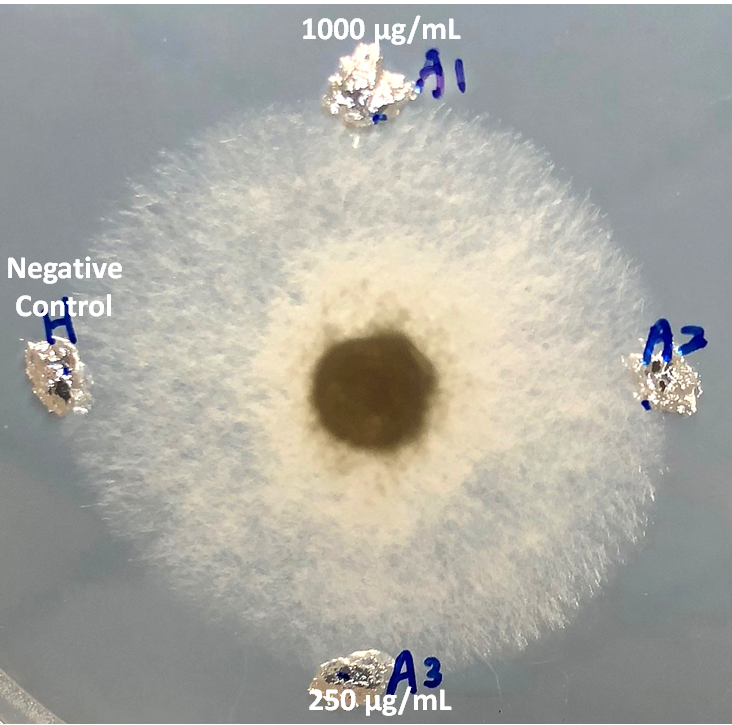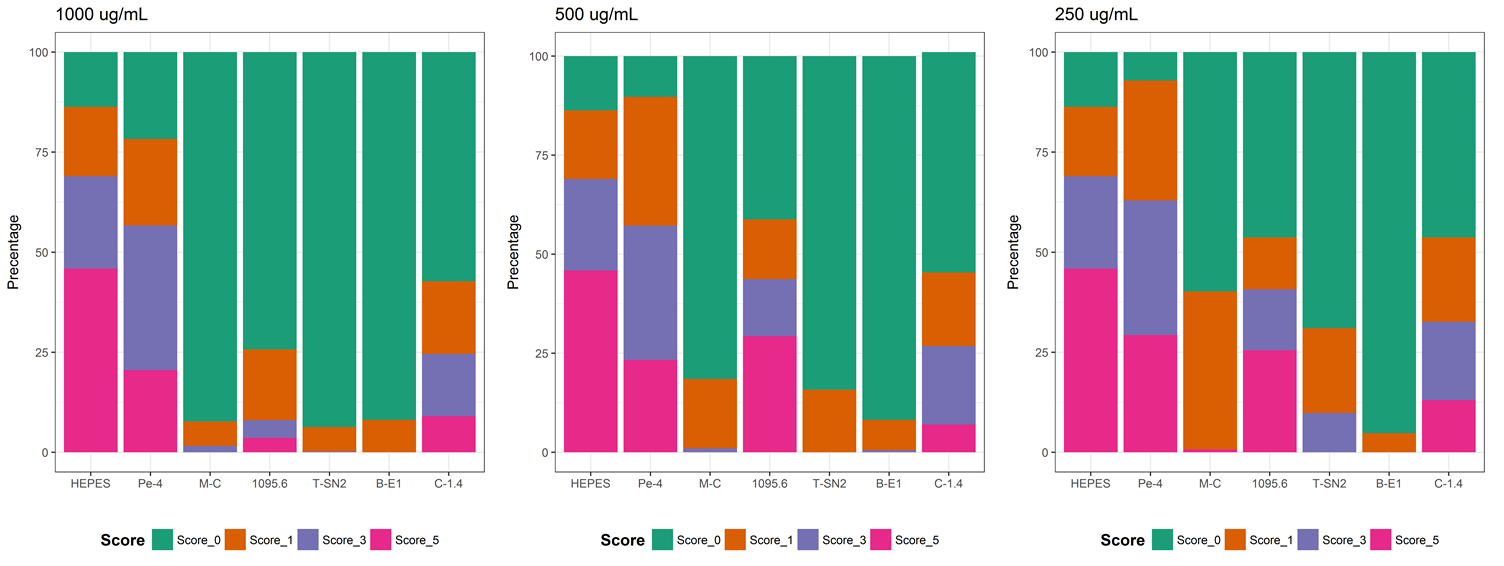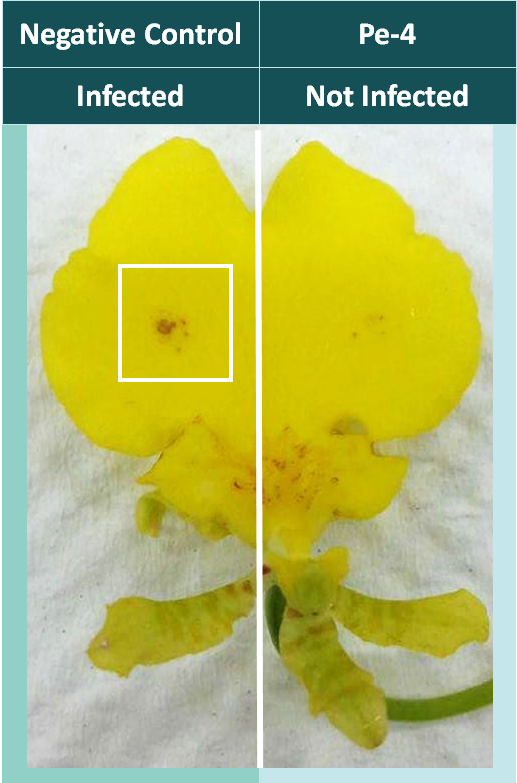Difference between revisions of "Part:BBa K2262013"
| Line 16: | Line 16: | ||
| | ||
| − | + | Pe-4 is an antimicrobial peptide [1]. The score of SCM analysis shows its promising potential to be antifungal. | |
<br> | <br> | ||
| Line 23: | Line 23: | ||
| | ||
| − | Pe-4 got 408.83 | + | Pe-4 got 408.83 from the Antifungal Scoring Card of Parabase System. The grade is score 353, the threshold to divide whether a peptide has an antifungal function probability, that means Pe-4 has a high probability to have an antifungal function. |
<br> | <br> | ||
<br> | <br> | ||
| Line 43: | Line 43: | ||
| | ||
| − | + | The result shows that the place we put Pe-4 has no different with negative control. It means the peptide has no obvious function on affecting the growth of mycelium. | |
| Line 51: | Line 51: | ||
<p style="padding:1px;font-size:14px"><b>(2) Spore Germination </b></p> | <p style="padding:1px;font-size:14px"><b>(2) Spore Germination </b></p> | ||
| | ||
| − | + | The result shows that the spore germination percentage of non-germinating spores adding Pe-4 with a concentration of 1000 μg/mL is higher than adding the negative control, which means the spore germination is inhibited by peptides and proves the peptides is effective. And the percentage of score_5 for Pe-4 is much less than the percentage of score_5 for the negative control. | |
| + | |||
| + | |||
| + | [[File:Spore Germination.png|900px|thumb|center|'''Figure 4.''' The result shows that Pe-4 might affect the germination of spore. ]] | ||
| + | <BR> | ||
<p style="padding:1px;font-size:14px"><b>(3) Botany Experiment </b></p> | <p style="padding:1px;font-size:14px"><b>(3) Botany Experiment </b></p> | ||
| | ||
| − | In order to test our anti-fungal peptides, we put Pe-4 and negative control, | + | In order to test our anti-fungal peptides, we put Pe-4 and negative control, double-distilled water, on the flower. The negative control is on the left and Pe-4 is on the right. Both sides are infected with Botrytis cinerea. We checked the flower 3 days later whether the flower was affected or not. The result shows that the right side, which was spread on Pe-4, is not infected. It means Pe-4 has an anti-fungal function in real plant organism. |
| Line 65: | Line 69: | ||
<p style="padding:1px;font-size:16px"><b>2. Cloning </b></p> | <p style="padding:1px;font-size:16px"><b>2. Cloning </b></p> | ||
| | ||
| − | We put T7 promoter, RBS, and Pe-4 together with pSB1C3 as a backbone. Then we conducted Taq PCR to check the size of the DNA sequence was right. The length of T7 promoter+RBS+ | + | We put T7 promoter, RBS, and Pe-4 together with pSB1C3 as a backbone. Then we conducted Taq PCR to check the size of the DNA sequence was right. The length of T7 promoter+RBS+Pe-4 is 120 b.p. Its PCR product is 432 b.p. |
| − | + | ||
<br> | <br> | ||
[[File:Agarose gel Pe-4.png|200px|thumb|center|'''Figure 6.''' P<sub>T7</sub> + RBS + Pe-4 <br> | [[File:Agarose gel Pe-4.png|200px|thumb|center|'''Figure 6.''' P<sub>T7</sub> + RBS + Pe-4 <br> | ||
| − | The DNA sequence length of P<sub>T7</sub> + RBS + Pe-4 is around 100 ~ 200 b.p | + | The DNA sequence length of P<sub>T7</sub> + RBS + Pe-4 is around 100 ~ 200 b.p. The size of its PCR product should be close to 450 ~ 500 b.p.]] |
| + | |||
| + | <br> | ||
| + | <br> | ||
| + | |||
| + | <h1>'''Reference'''</h1> | ||
| + | |||
| + | [1] Bai RL; Pettit GR; Hamel E. “Binding of dolastatin 10 to tubulin at a distinct site for peptide antimitotic agents near the exchangeable nucleotide and vinca alkaloid sites.” J Biol Chem. 1990 Oct 5;265(28):17141-9. | ||
| + | <br> | ||
| + | <br> | ||
<!-- Add more about the biology of this part here | <!-- Add more about the biology of this part here | ||
Latest revision as of 15:07, 7 December 2017
T7 Promoter+RBS+Pe-4
Introduction
Pe-4 is an antimicrobial peptide [1]. The score of SCM analysis shows its promising potential to be antifungal.
Scoring Card Predict
Pe-4 got 408.83 from the Antifungal Scoring Card of Parabase System. The grade is score 353, the threshold to divide whether a peptide has an antifungal function probability, that means Pe-4 has a high probability to have an antifungal function.
Experiment
1. Fungal Test
(1) Inhibition Zone
The result shows that the place we put Pe-4 has no different with negative control. It means the peptide has no obvious function on affecting the growth of mycelium.
(2) Spore Germination
The result shows that the spore germination percentage of non-germinating spores adding Pe-4 with a concentration of 1000 μg/mL is higher than adding the negative control, which means the spore germination is inhibited by peptides and proves the peptides is effective. And the percentage of score_5 for Pe-4 is much less than the percentage of score_5 for the negative control.
(3) Botany Experiment
In order to test our anti-fungal peptides, we put Pe-4 and negative control, double-distilled water, on the flower. The negative control is on the left and Pe-4 is on the right. Both sides are infected with Botrytis cinerea. We checked the flower 3 days later whether the flower was affected or not. The result shows that the right side, which was spread on Pe-4, is not infected. It means Pe-4 has an anti-fungal function in real plant organism.
2. Cloning
We put T7 promoter, RBS, and Pe-4 together with pSB1C3 as a backbone. Then we conducted Taq PCR to check the size of the DNA sequence was right. The length of T7 promoter+RBS+Pe-4 is 120 b.p. Its PCR product is 432 b.p.
Reference
[1] Bai RL; Pettit GR; Hamel E. “Binding of dolastatin 10 to tubulin at a distinct site for peptide antimitotic agents near the exchangeable nucleotide and vinca alkaloid sites.” J Biol Chem. 1990 Oct 5;265(28):17141-9.
Sequence and Features
- 10COMPATIBLE WITH RFC[10]
- 12COMPATIBLE WITH RFC[12]
- 21COMPATIBLE WITH RFC[21]
- 23COMPATIBLE WITH RFC[23]
- 25COMPATIBLE WITH RFC[25]
- 1000COMPATIBLE WITH RFC[1000]






